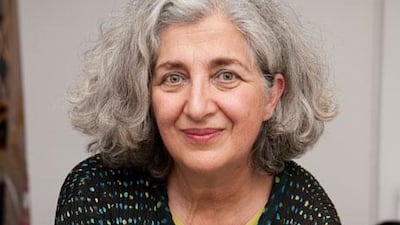Raeda Saadeh is a Palestinian photographer who lives in Jerusalem and has an Israeli passport. She is Muslim, but is compelled to speak and teach in Hebrew. When there is an exhibition of her work in Lebanon or Dubai, or indeed any Arab country, she cannot attend.
Art: The National looks
Exhibitions, reviews, news, features and all things art
Her life is one of censorship, violence, checkpoints and curfews, and she is not alone. A book of work by Middle Eastern photographers, to be launched at Abu Dhabi Art, which opens tonight, captures the frustration, sadness and anger at the injustices that afflict so many in the Arab world.
As the London-based gallerist Rose Issa, the co-editor of the book Arab Photography Now, says: "These pictures do reflect our daily concerns. Why can't the woman work? Why can't women drive? Why can't the workers in our countries have some minimum human rights? No one with any intelligence would accept those kind of situations. The trouble is we are not at ease in our countries."
Issa is a curator, writer and producer who has championed visual art and film from the Arab world and Iran for nearly 30 years. She is showing at Abu Dhabi Art as well as exhibiting the work of the Lebanese painter Ayman Baalbaki in London. A disarmingly charming woman in her 60s, half Iranian, half Lebanese, she has lived in the UK capital for 25 years. In 2008, she opened a gallery in Kensington, west London, prosaically sandwiched between an Italian restaurant and a dry-cleaner's.
"My motivation was - and is - to give a platform and a voice to the artists from Iran and the Middle East," she says. "Anyone who lives in the Middle East always thinks that our politicians do not perceive or present our ideas the way we feel they should be. As you see with the Arab Spring, it has been the artists who have explored the concerns of the public - the aesthetic issues, the political, social and moral."
It was not until 20 or 30 years ago that photography was considered for its own value and not just used in documentaries or journalism, says Issa, and the photographic galleries in Europe and more so in the Middle East are relatively recent.
"Now we have fashion photography with shows for designers such as Steve McQueen, and Middle Eastern photography is being shown at the Venice Biennale. So many things that were not considered art are now mainstream."
The 31 photographers featured in the book - two work as a team - are drawn from the 22 countries of the Arab world that are "united by a common arena where they speak the same language and have the same religion", but many are leading what Issa calls "in-between lives", sharing their time in cities such as Berlin, Paris, London and New York with visits to their homelands.
Saadeh has adopted the role-playing genre exemplified by Cindy Sherman. But where Sherman's work is an amusing confection, Saadeh's representations are poignant creations of alter egos such as Diana, the ancient Roman goddess of hunting, a Vermeer milkmaid in an abandoned farm, a despairing Cinderella in Old Jerusalem during the curfew. These all illustrate the photographer's repression in a territory where there are houses with no roofs, villages with no life, many still ringed with mines.
While Saadeh's is a work of frustrated fantasy, Gaza-born Taysir Batniji, who was expelled from his country and now lives in Paris, is very direct; his series of Israeli watchtowers is reminiscent of the concentration camps of the 1940s. The London-based Iraqi Jananne Al Ani has taken a set of pictures from a helicopter of defensive positions in the desert between Iraq and Jordan. They are stark and threatening, like some geometric abstract art devised by a drone.
In War Trophies, Khalil Joreige and Joana Hadjithomas have uncompromisingly photographed the wrecked jeeps, guns and armoured vehicles abandoned in the rubble of their war-torn landscape. More telling perhaps, their series Wonder Beirut is based on postcards from the late 1960s, showing the hotels that flourished then but are now destroyed.
Not all the photographers use the imagery of desolation.
Hassan Hajjaj, who divides his time between Marrakech and London, where he also works as a DJ, noticed while helping on a fashion shoot for Elle magazine in the 1990s that everyone on the set was European. His photographs do something to redress the balance, with lighthearted scenes of Moroccan life - girls winking, striking a pose in an alley, a musician on his violin.
Omar D is an eye specialist in Paris but for three months a year he spends his "in between" life in his home country Algeria, where he treats people free of charge. His works are luscious celebrations of Berber lives and customs.
The book is part of Issa's goal to generate greater knowledge of the work of Middle Eastern artists, whether in film, art or photography.
"The problem is we do not have enough documentation of our artistic heritage. So much has been neglected because of war and oppression. Lebanon is just waking up to the idea of cataloguing books on its own culture, but Iranian students cannot see films from before the revolution because girls are in miniskirts and their hair is showing. They don't have access to their own culture."
Follow us on Twitter and keep up to date with the latest in arts and lifestyle news at twitter.com/LifeNationalUAE

